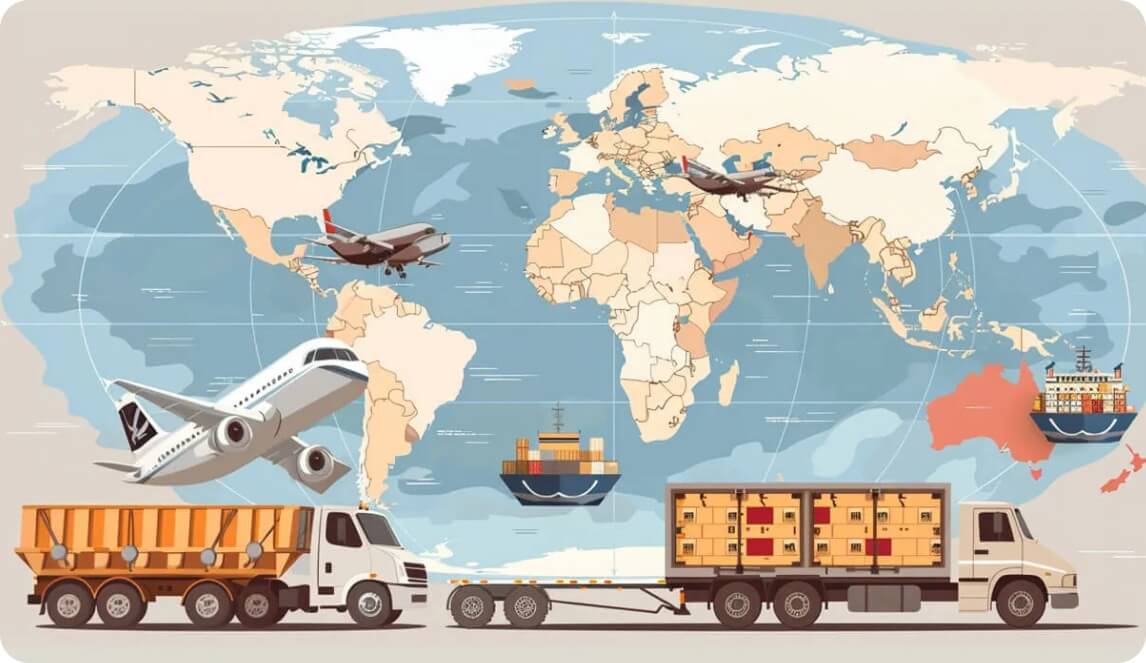Get in touch


A Beginner's Guide to International Shipping: Documentation, Incoterms, and Customs Basics
June 27, 2025
Tejan

Ever wondered how the mobile phone you are using ended up in your palms?
It’s a result of countless import and export processes and is not the product of just one company or one country. For this phone to be manufactured, a lot of things need to happen in perfect sequence. Parts made in different countries need to be shipped across oceans and skies, all coming together to the right place.
So how do such complex tasks get executed every day?
The answer is that international shipping makes this happen.
Yes, this is how your phone gets its screen from South Korea, its chip from Taiwan, and its battery from China before being assembled somewhere else entirely. Then, it’s packed, tracked, and delivered right to your doorstep.
At Atlantic Courier, we not only provide shipping services that make sure your goods are delivered to their destination but also ensure complete documentation and customs assistance. With us, your package is as good as delivered the moment you hand it to us!
Let us walk you through the process of international shipping and how we execute it seamlessly.
The Step-by-Step Process
Order Placement
Customer places an order → Seller confirms availability and destination
This is the first spark that ignites this well-oiled machine. The customer can place an order through multiple methods, such as B2B contracts, websites, e-commerce platforms, direct orders, etc. The seller then confirms product availability, destination requirements, and shipping preferences.
Understanding Incoterms
At this stage, the buyer and seller also agree on Incoterms (International Commercial Terms). These standardized trade terms define who is responsible for the following at each stage: shipping, insurance, customs clearance, and delivery. Choosing the right Incoterm ensures clarity and prevents disputes later in the process.
Packaging & Labeling
Goods are packed securely → Labels include destination, HS code, and handling instructions
Proper packing is not just essential for the appeal but also for the safety of the goods and compliance. HS code, also known as Harmonized System code, is a globally standardized numerical system used to classify traded products. Developed and maintained by the World Customs Organization (WCO), it’s used by over 200 countries.
At Atlantic, we offer free packaging to all our customers to make sure their goods reach their destination without any damage. We even take care of all other aspects involved, such as labeling, HS Codes, etc.
Documentation Preparation
This is where it starts getting complex. An unimaginable amount of goods and cargo passes through a number of checks before heading out on the journey. Hence, very highly developed systems facilitate these processes, and for that to happen, it is important that each deliverable is properly documented, hence ensuring compliance with all the laws and regulations and customs checks.
Key documents are created :
- Commercial Invoice - Lists the buyer, seller, goods, value, and terms
- Packing List - Details contents, dimensions, and weight
- Bill of Lading - Acts as a contract and receipt between shipper and carrier
- Certificate of Origin - Declares where the goods were manufactured
- Insurance Certificate - Covers loss or damage during transit
- Export/Import Licenses - Required for restricted goods or certain countries.
Because documentation requires precision, it’s best to rely on a trusted shipping provider. At Atlantic, we ensure every document is accurate and compliant.
Download the checklist from here : https://atlanticcourier.net/documents
You can also stay tuned to our website for any updates regarding the same.
Carrier Booking
Shipping method selected (air, sea, or courier) → Carrier is booked based on cost, speed, and destination.
All sizes do not fit one. Similarly, there is no universal shipping method that is applicable and the optimum choice for every delivery. It is mainly dependent on the cost, speed, and destination. The following are widely opted for:
- Air Freight - Fast but expensive, ideal for high-value or time-sensitive goods.
- Sea Freight - Economical for large shipments, but slower.
- Courier Services - Convenient for small parcels with door-to-door delivery. The seller or freight forwarder books the shipment and coordinates pickup.
Atlantic Courier helps you choose the best method and ensures a seamless experience regardless of the size or type of goods. For us, all customers are the same, and we prioritize everyone.
Export Customs Clearance
Goods are declared to local customs → Export duties and inspections are handled.
This process involves declaring the goods to the local/export customs. This involves:
- Submitting documentation
- Paying any export duties or fees
- Undergoing inspections if required. A customs broker often handles this step to ensure compliance and avoid delays.
A customs broker often manages this process to ensure compliance and avoid delays.
Customs checks and inspections have always been complicated, but our experience with them has always been simple. Goods handled by us have never been held up by customs checks. All thanks to our dedicated team, who work around the clock to make this happen.
We will assist you in every way possible! All we need is your trust at Atlantic!
Transit & Tracking
Shipment is in motion → Real-time tracking begins → Carrier updates status
Once our goods are good to go, tracking comes into action. As most goods pass through multiple hubs, ports, etc., most carriers offer real-time updates, allowing both sender and receiver to monitor progress.
Your goods finally get in motion. But the uncertainty of the transit will make anyone worried. But don’t you worry! At Atlantic, we offer real-time tracking and help you calm your nerves.
Import Customs Clearance
Arrival at destination country → Customs checks documents, assesses duties/taxes → Clearance granted.
Upon arrival in the destination country, the shipment undergoes customs clearance again. This is very much similar to the earlier process of declaring export customs, but only in reverse.
Final Delivery
Goods handed to local courier or freight handler → Delivered to end customer
For the last part, the shipment is handed over to a local courier or freight handler for final delivery. This could be to a warehouse, retail outlet, or directly to the customer’s doorstep.
At this point, the international shipping process is complete.
FAQs
We cover over 180+ countries with more to be covered soon. Check out our website to know more.
Click here to access the checklist. You can also stay tuned to our website for any updates regarding the same.
HS Code stands for Harmonized System Code. It is mainly comprised of 6 digits and is a globally standardized numerical system used by over 200 countries to classify goods undergoing trade. It is developed and maintained by the World Customs Organization (WCO).
For more info click here: More Info
We offer shipping services for almost every item as long as it is not prohibited.
Do check out the list of prohibited items here .
We also provide specialized delivery services for medicines, food items, and documents.
We offer real-time tracking updates. You can track your package on our live tracking tool .
We recommend opting for medical courier service as we specialize in medicine delivery. Click here to know more.
Incoterms are three-letter trade codes published by the International Chamber of Commerce (ICC). They are internationally recognized rules that define the roles of buyers and sellers in global shipping.
For more info visit here


